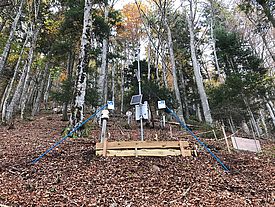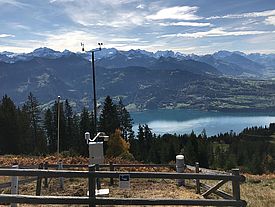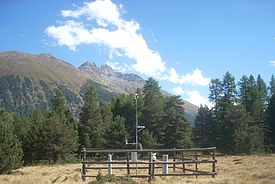Weather conditions, climate and air pollution are important external factors that influence processes in forest ecosystems. We have been continuously measuring the most important parameters on LWF sites for more than 20 years.
Weather conditions and climate
Climate is mainly determined by temperature and precipitation and their annual variations. Both are decisive for tree growth. On each LWF site we record them, together with other weather parameters, using two weather stations (2) – one in the stand and one in the nearby open field. This allows us to study climatic issues and the relationships between processes inside and outside the forest. The LWF weather stations have been reliably measuring data at 10-minute intervals for 20 years.
Air pollution
Various processes contribute to air pollution. Most of these are human activities, whereby the burning of fossil fuels is the main factor. However, the use of fertilisers in agriculture also leads to emissions of nitrogen and nitrous oxide, which pollute the air. The air pollutants thus released can damage trees.
Air pollution can affect forest ecosystems indirectly, for example by increasing the availability of certain nutrients. In the form of gas, aerosols or dissolved in precipitation, nutrients such as sulphur and nitrogen enter the forest ecosystems. In excessive amounts, nitrogen can disturb the nutrient balance of the trees.
On LWF sites, both in open field and under forest cover, rainwater collectors (3) and snow collectors (4) record the sulphur and nitrogen compounds dissolved in precipitation in order for us to quantify the total inputs of these and other nutrients and pollutants (atmospheric deposition).
We use stemflow collectors (10) to determine the amount of nutrients and pollutants or the proportion of these substances entering the soil along the stem. Passive collectors measure the air concentrations of nitrogen dioxide (5) and ammonia (6), and contribute to a more accurate determination of the total nitrogen input.
In addition to these indirect effects, forest ecosystems are also polluted by ozone (O3). This secondary pollutant is formed from NO2 and is absorbed directly through the stomata of leaves and needles. It can reduce photosynthesis capacity and thus the growth of trees. During the growing season, ozone passive collectors (7), ozone monitors (8) and a wireless ozone measuring system (9) monitor the concentrations of this air pollutant.



